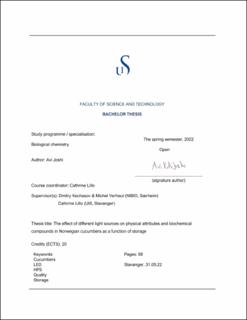| dc.description.abstract | The cucumber is an important crop for greenhouse cultivation in northern latitudes such as in Norway, where light and temperature requirements are not met year around for cucumber cultivation. Producing a consistently satisfactory crop and influencing favorable consumer traits including physical attributes and biochemical compounds is therefore of key concern. Light quantity and quality are principal factors determining the development and subsequent quality of crops such as the cucumber and emerging research indicates that light emitting diodes can improve both levels of biochemical compounds and physical traits in crops as opposed to traditional high pressure sodium lamps in a greenhouse environment. The manipulation of these factors has potential for prolonging desired traits both in terms of taste and nutritional enhancement and physical parameters in cucumbers across storage and presents an intriguing concept. Examining how light treatments combining overhead light emitting diodes and high-pressure sodium lamps with intracanopy light emitting diodes affect two different parthenocarpic smooth cucumber cultivars, IMEA and DeeRect with regards to a selection of physical and chemical parameters when freshly harvested and after 4 weeks of storage was therefore the focus of this thesis. A taste test was also conducted to possibly correlate the experimental findings with consumer taste preference. The physical parameters measured consisted of length, diameter, weight and perceived color measurements, whilst the chemical parameters consisted of dry matter content, soluble solid content, pH, total titratable acid content measurements, vitamin C content, pigment content and ionic content.
Both the physical and chemical parameters expressed variability to different light combinations in both cultivars, though the IMEA cultivar was affected to a greater extent. The use of light emitting diodes had a positive effect on both physical and chemical parameters particularly in the IMEA cultivar, though both cultivars had similar declining results in response to storage and only perceived color for the IMEA cultivar and the carotenoid content in the DeeRect cultivar appeared to exhibit different values after storage as a function of light treatment. The DeeRect cultivar expressed higher overall favorable values for the measured parameters indicating the importance of cultivar choice on set parameters. | |
